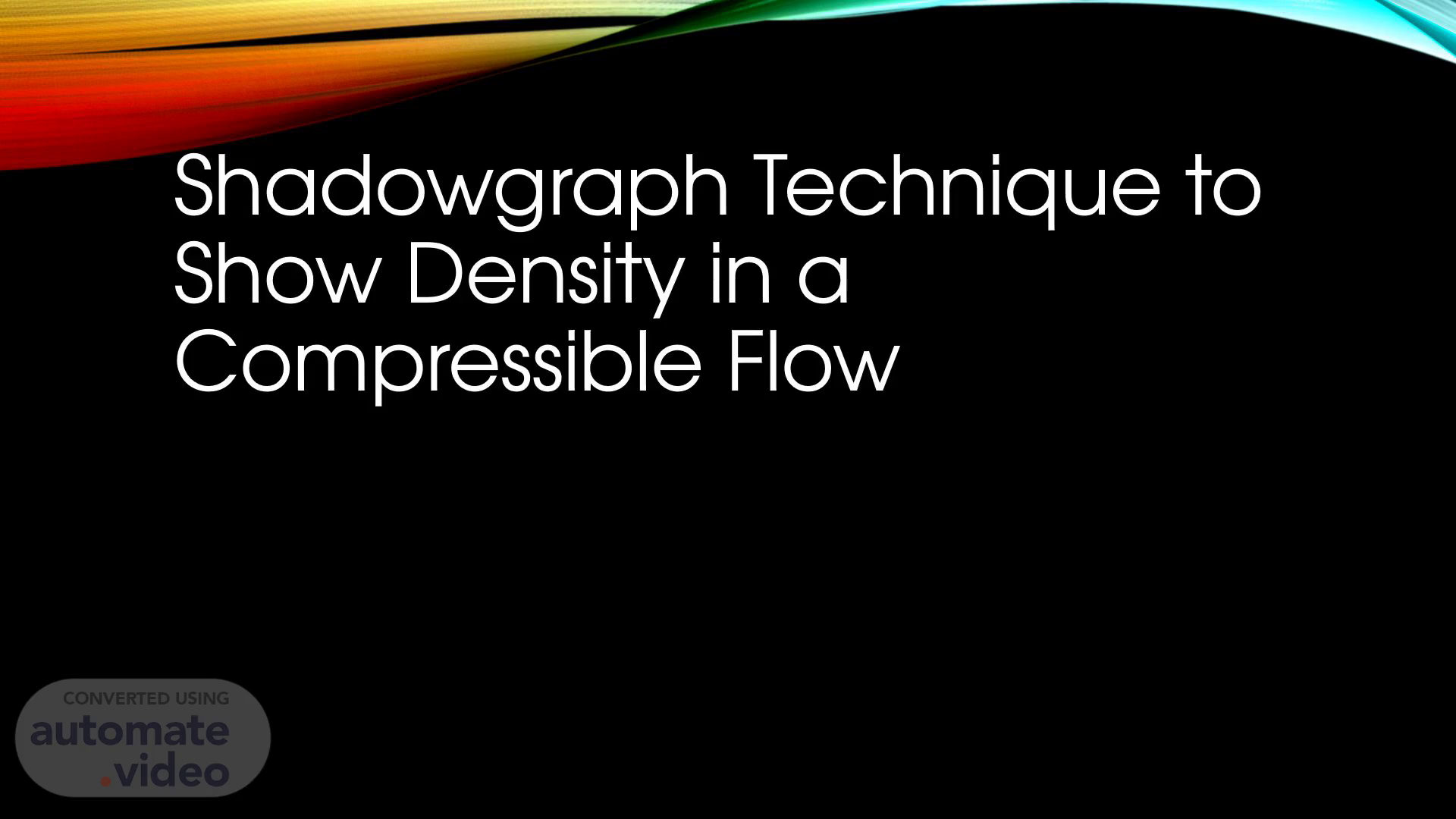
Shadowgraph Technique to Show Density in a Compressible[1] - Read-Only.pptx
Scene 1 (0s)
[Audio] Shadowgraph Technique to Show Density in a Compressible Flow 1.
Scene 2 (11s)
[Audio] Introduction to Compressible Compressible flow deals with gas dynamics where density changes. Occurs when Mach number is greater than 0.3. Important in high-speed aerodynamics. Density variations lead to pressure and temperature differences. Common in jet engines, rockets, and supersonic aircraft..
Scene 3 (34s)
[Audio] Introduction to Shadowgraph Technique Shadowgraph visualizes changes in refractive index. Sensitive to density gradients in compressible flow. Simple setup with light source and recording screen. Allows visualization of shock waves, turbulence. Common in research on supersonic flows..
Scene 4 (1m 5s)
[Audio] The principle behind the Shadowgraph Technique is based on the deflection of light rays due to density gradients in a transparent medium. Here's a concise breakdown Refraction and Density Gradients Light Deflection: When light travels through a medium with varying density (like air with different temperatures or pressures), its speed changes, causing it to bend or refract. Density Gradients: In compressible flows, such as supersonic jets or shock waves, these density variations are significant and create distinct gradients..
Scene 5 (1m 44s)
[Audio] Equipment Setup for Shadowgraph Light Source: Typically a bright lamp or laser that emits a collimated beam of light. Test Section: The region containing the flow of interest, such as a wind tunnel or a flow chamber. Recording Plane: A screen or camera that captures the shadow patterns. Light Source: Emits a collimated beam of light that travels through the test section. This beam needs to be uniform and parallel for accurate deflection patterns. Test Section: The flow of interest, with varying density gradients due to compressible flow phenomena like shock waves or supersonic jets, is placed here. The light beam passes through these density variations and refracts (bends) according to changes in density. Recording Plane: The refracted light creates shadows and bright spots on the recording plane, corresponding to the density variations in the flow. The recording plane can be a simple screen for visual observation or a camera for capturing detailed images for further analysis. Requires a point light source (for example, laser or LED). A flow chamber to observe the compressible flow. A screen or camera to capture the shadowgraph image. Mirrors and lenses may enhance the image. Simple setups can be achieved with minimal equipment. 11.
Scene 6 (3m 6s)
[Audio] Typical shadowgraph images showing the dominant flow features observed around a hemispherical forebody with and without spike configuration. At Mach number M = 2.0. Flow features: 1. Weak leading edge shock, 2. Expansion fan, 3. Separation shock, 4. Separated free shear layer, 5. Re-circulation region, 6. Reattachment shock, 7. Large scale structures, 8. Shocklets. In case of the forebody without a spike, a strong bow shock is seen. Flow is from left to right.
Scene 8 (3m 50s)
[Audio] Visualization Techniques in Compressible Several methods: Schlieren, Shadowgraph, and Interferometry. They highlight density gradients in flow. Key for understanding shock waves and expansion fans. Schlieren and Shadowgraph are non-intrusive techniques. Used to study supersonic and hypersonic flow..
Scene 9 (4m 15s)
[Audio] Advantages of Shadowgraph TechniqueThe Shadowgraph Technique has several advantages: Simplicity: Easy to set up and use, requiring minimal equipment. Cost-Effective: Relatively inexpensive compared to other flow visualization methods. Real-Time Visualization: Provides immediate visual feedback of density variations. Non-Intrusive: Doesn't interfere with the flow, preserving its natural behavior. Wide Applications: Useful in a variety of fields like aerodynamics, combustion research, and meteorology..
Scene 10 (4m 55s)
[Audio] Applications in Compressible Flow Research Used in wind tunnels to study supersonic flows. Applied in hypersonic flow research for reentry vehicles. Key for studying shock wave-turbulence interactions. Important in aerospace propulsion systems. Helps in understanding complex flow phenomena. 8.
Scene 11 (5m 16s)
[Audio] 10. Schlieren vs Shadowgraph. Shadowgraph - an overview | ScienceDirect Topics.
Scene 12 (5m 24s)
[Audio] Recent Advances in Shadowgraphy Digital shadowgraph techniques enhance clarity High-speed cameras allow for real-time visualization. Laser-based systems for precise density measurements. Advanced processing for 3D flow field reconstructions. Improved for hypersonic and reentry vehicle testing. 12.
Scene 13 (5m 46s)
[Audio] Limitations of Shadowgraph Technique Less sensitive compared to Schlieren. Does not provide quantitative data. May not capture fine details in flow. Sensitive to alignment and light source quality. Not suitable for low-speed or incompressible flows. 13.
Scene 14 (6m 3s)
[Audio] Conclusion Shadowgraph Technique offers a straightforward yet powerful method for visualizing density variations in compressible flows. By utilizing light deflection caused by density gradients, this technique provides immediate and non-intrusive insights into complex flow phenomena such as supersonic jets, shock waves, and explosions. Its simplicity, cost-effectiveness, and real-time visualization make it a valuable tool in various fields, from aerodynamics to combustion research. Whether you're a researcher or an engineer, mastering this technique can significantly enhance your understanding of fluid dynamics..